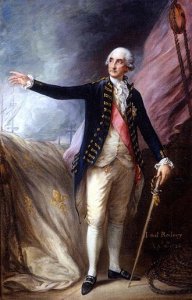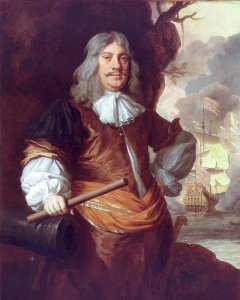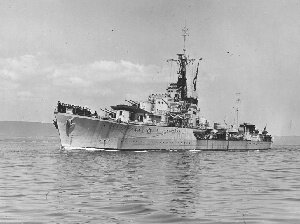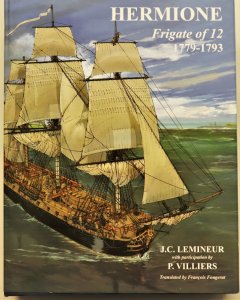Today in Naval History - Naval / Maritime Events in History
21st of May
please use the following link and you will find the details and all events of this day ..... in the following you will find some of the events
1565 - The Battle of Rügen
was a naval battle near the island of Rügen (in modern Germany), that took place on 21 May 1565 between an allied fleet of 6 Danish and 3 Lübeck ships, and a Swedish fleet of 48 ships with a total of 1,638 guns and 8,000 men under Klas Horn.
The Swedish fleet was victorious, and 4 of the allied ships were burned, while the remaining 5 were captured.
1692 – Launch of HMS Boyne, an 80-gun third-rate ship of the line of the Royal Navy, launched at Deptford Dockyard

Scale: 1:48. A contemporary Navy Board model of the 'Boyne' (1692),
1692 - The Action at Cherbourg was fought on 21 and 22 May Old Style (1st and 2 June New Style) 1692 as part of the aftermath of the Battle of Barfleur which had just been fought on 19 May (Old Style) 1692.
All six french ships including the Soleil Royal burned

Destruction of the French flagship Soleil Royal


1692 - The Action at La Hogue (21–24 May OS(1–4 June(NS)), 1692)
occurred during the pursuit by the English of the French fleet after the Battle of Barfleur during the Nine Years' War.
The pursuing English fleet, under the command of Admiral of the Fleet Edward Russell, 1st Earl of Orford, destroyed a number of French ships that had been beached near the port of Saint-Vaast-la-Hougue.

The action at La Hogue in May 1692 formed a crucial scene in the wider context of the Battle of Barfleur
1760 – Launch of French Protecteur, a Souverain-class 74-gun ship of the line of the French Navy, the only to have borne the name.

Scale model on display at the Musée de la Marine in Paris. This model is a 64-gun, probably mislabeled.
1768 - The Venetian Arsenal ship San Carlo Borromeo, a San Carlo Borromeo-class ship of the line 66-gun third rate, foundered
1776 – Launch of USS Raleigh, one of thirteen ships that the Continental Congress authorized for the Continental Navy in 1775

Model of the USS Raleigh in the U.S. Navy Museum
1788 – Launch of French America, a Téméraire-class 74-gun ship of the line of the French Navy

Scale: 1:48. Plan showing the body plan, stern board outline, sheer lines with inboard detail, and longitudinal half-breadth for 'America' (1794),

This print is one of a series depicting the six French ships captured by the British fleet under Admiral Lord Howe at the Battle of the First of June, 1794, which took place 400 (nautical) miles west of the French island of Ushant. This plate, the first in the series, portrays L'Amerique ('America'), left,
1793 - the British privateer Active was captured by French frigate Sémillante
On 21 May 1793, Sémillante captured the Liverpool privateer Active. She was under the command of Captain Stephen Bower, and was sailing under a letter of marque dated 2 May 1793. The letter of marque described her as a sloop of 100 tons burthen (bm), armed with twelve 4-pounder guns and four swivel guns, and having a crew of 40 men. The British later recaptured Active and sent her into Guernsey. The next day Sémillante captured the Guernsey privateer Betsey, of 10 guns and 55 men.

1800 - Boats of HMS Minotaur (74), Cptn. Thomas Louis, & consorts cut out a galley La Prima, Cptn. Patrizio Galleano, from Genoa.
HMS Minotaur was a 74-gun third-rate ship of the line of the Royal Navy, launched on 6 November 1793 at Woolwich. She was named after the mythological bull-headed monster of Crete. She fought in three major battles - Nile, Trafalgar, and Copenhagen (1807) - before she was wrecked, with heavy loss of life, in December 1810.

The shipwreck of the Minotaur, oil on canvas, by J. M. W. Turner
1800 - HMS Peterel captured french Ligurienne
In March 1800, HMS Peterel was sailing near Marseille with the frigate HMS Mermaid. On 21 March, Peterel spotted a large convoy with three escorts: the brig-sloop French brig Ligurienne, armed with fourteen brass 6-pounder guns and two brass 36-pounder howitzers, the corvette Cerf, of fourteen 6-pounder guns, and the xebec Lejoille, of six 6-pounder guns.
Peterel captured a bark of 350 tons and a bombarde (ketch) of 150 tons, both carrying wheat and which their crews had abandoned, and sent them off with prize crews; later that afternoon the escorts caught up to Peterel and attacked. Mermaid was in sight but a great distance to leeward and so unable to assist. Single-handedly, Peterel drove Cerf and Lejoille on shore, and after a 90-minute battle captured Ligurienne, which lost the French commander (lieutenant de vaisseaux Citoyen Francis Auguste Pelabon), and one sailor killed and two sailors wounded out of her crew of 104 men; there were no British casualties. Cerf was a total loss but the French were able to salvage Lejoille. The whole action took place under the guns of two shore batteries and so close to shore that Peterel grounded for a few minutes. Austen recommended, without success, that the Navy purchase Ligurienne, which was less than two years old. In 1847 the Admiralty authorised the issue of the Naval General Service medal with clasp "Peterel 21 March 1800" to all surviving claimants from the action.

Battle between Ligurienne and HMS Peterel, 30 Ventôse an VIII (21 March 1800). Aquatint by Antoine Roux.
1809 - HMS Goldfinch (6) and HMS Black Joke (6) versus french Mouche (16), 17th May 1809 - 21st May 1809
On May 17th 1809, the Goldfinch, 10, Commander Fitzowen George Skinner, gave chase to the French corvette Mouche, 16, in lat. 44 6 ! N., long. 11 20' W. The Mouche, though greatly superior in force, attempted to avoid an action. She was overtaken on the 18th, but, firing high, inflicted so much injury upon the Goldfinch's masts and sails that she was able to escape. On the 21st, she exchanged some broadsides with the hired armed lugger Black Joke, Lieutenant Moses Cannadey, and entered the Spanish port of Santander, where she was captured on June 10th by the British frigates Amelia, 38, and Statira, 38.

1860 – Launch of French Ville de Bordeaux, a Ville de Nantes-class 90-gun ship of the line of the French Navy

1879 - Naval Battle of Iquique
The Battle of Iquique (Spanish: Batalla de Iquique or Combate naval de Iquique) was a confrontation that occurred on 21 May 1879, during the naval stage of the War of the Pacific, a conflict that pitted Chile against Peru and Bolivia. The battle took place off the then-Peruvian port of Iquique. The Peruvian ironclad Huáscar, commanded by Miguel Grau Seminario, sank Esmeralda, a Chilean wooden corvette captained by Arturo Prat Chacón, after four hours of combat.

Painting by Thomas Somerscales of the sinking of Esmeralda by Huáscar during the Battle of Iquique
1879 - The Battle of Punta Gruesa - a naval action and final ending of the Battle of Iquique
The Battle of Punta Gruesa was a naval action that took place on May 21, 1879, during the War of the Pacific between Chile and Peru. This may be labelled as the second part of the Naval Battle of Iquique, although it is described in many sources as a separate battle.

Naval Combat of Punta Gruesa - The stranding of the Independencia
1918 - The Action of 21 May 1918 was a naval engagement of World War I fought between an American armed yacht and a German submarine in the Atlantic Ocean off Spain.

USS Christabel in 1917.
21st of May
please use the following link and you will find the details and all events of this day ..... in the following you will find some of the events
Naval/Maritime History - 27th of August - Today in Naval History - Naval / Maritime Events in History
Today in Naval History - Naval / Maritime Events in History Other Events on 20 May 1497 – John Cabot sets sail from Bristol, England, on his ship Matthew looking for a route to the west (other documents give a May 2 date). John Cabot (Italian: Giovanni Caboto [dʒoˈvanni kaˈbɔːto]; c. 1450 –...
shipsofscale.com
1565 - The Battle of Rügen
was a naval battle near the island of Rügen (in modern Germany), that took place on 21 May 1565 between an allied fleet of 6 Danish and 3 Lübeck ships, and a Swedish fleet of 48 ships with a total of 1,638 guns and 8,000 men under Klas Horn.
The Swedish fleet was victorious, and 4 of the allied ships were burned, while the remaining 5 were captured.
1692 – Launch of HMS Boyne, an 80-gun third-rate ship of the line of the Royal Navy, launched at Deptford Dockyard
Scale: 1:48. A contemporary Navy Board model of the 'Boyne' (1692),
1692 - The Action at Cherbourg was fought on 21 and 22 May Old Style (1st and 2 June New Style) 1692 as part of the aftermath of the Battle of Barfleur which had just been fought on 19 May (Old Style) 1692.
All six french ships including the Soleil Royal burned
Destruction of the French flagship Soleil Royal
1692 - The Action at La Hogue (21–24 May OS(1–4 June(NS)), 1692)
occurred during the pursuit by the English of the French fleet after the Battle of Barfleur during the Nine Years' War.
The pursuing English fleet, under the command of Admiral of the Fleet Edward Russell, 1st Earl of Orford, destroyed a number of French ships that had been beached near the port of Saint-Vaast-la-Hougue.
The action at La Hogue in May 1692 formed a crucial scene in the wider context of the Battle of Barfleur
1760 – Launch of French Protecteur, a Souverain-class 74-gun ship of the line of the French Navy, the only to have borne the name.
Scale model on display at the Musée de la Marine in Paris. This model is a 64-gun, probably mislabeled.
1768 - The Venetian Arsenal ship San Carlo Borromeo, a San Carlo Borromeo-class ship of the line 66-gun third rate, foundered
1776 – Launch of USS Raleigh, one of thirteen ships that the Continental Congress authorized for the Continental Navy in 1775
Model of the USS Raleigh in the U.S. Navy Museum
1788 – Launch of French America, a Téméraire-class 74-gun ship of the line of the French Navy
Scale: 1:48. Plan showing the body plan, stern board outline, sheer lines with inboard detail, and longitudinal half-breadth for 'America' (1794),
This print is one of a series depicting the six French ships captured by the British fleet under Admiral Lord Howe at the Battle of the First of June, 1794, which took place 400 (nautical) miles west of the French island of Ushant. This plate, the first in the series, portrays L'Amerique ('America'), left,
1793 - the British privateer Active was captured by French frigate Sémillante
On 21 May 1793, Sémillante captured the Liverpool privateer Active. She was under the command of Captain Stephen Bower, and was sailing under a letter of marque dated 2 May 1793. The letter of marque described her as a sloop of 100 tons burthen (bm), armed with twelve 4-pounder guns and four swivel guns, and having a crew of 40 men. The British later recaptured Active and sent her into Guernsey. The next day Sémillante captured the Guernsey privateer Betsey, of 10 guns and 55 men.
1800 - Boats of HMS Minotaur (74), Cptn. Thomas Louis, & consorts cut out a galley La Prima, Cptn. Patrizio Galleano, from Genoa.
HMS Minotaur was a 74-gun third-rate ship of the line of the Royal Navy, launched on 6 November 1793 at Woolwich. She was named after the mythological bull-headed monster of Crete. She fought in three major battles - Nile, Trafalgar, and Copenhagen (1807) - before she was wrecked, with heavy loss of life, in December 1810.
The shipwreck of the Minotaur, oil on canvas, by J. M. W. Turner
1800 - HMS Peterel captured french Ligurienne
In March 1800, HMS Peterel was sailing near Marseille with the frigate HMS Mermaid. On 21 March, Peterel spotted a large convoy with three escorts: the brig-sloop French brig Ligurienne, armed with fourteen brass 6-pounder guns and two brass 36-pounder howitzers, the corvette Cerf, of fourteen 6-pounder guns, and the xebec Lejoille, of six 6-pounder guns.
Peterel captured a bark of 350 tons and a bombarde (ketch) of 150 tons, both carrying wheat and which their crews had abandoned, and sent them off with prize crews; later that afternoon the escorts caught up to Peterel and attacked. Mermaid was in sight but a great distance to leeward and so unable to assist. Single-handedly, Peterel drove Cerf and Lejoille on shore, and after a 90-minute battle captured Ligurienne, which lost the French commander (lieutenant de vaisseaux Citoyen Francis Auguste Pelabon), and one sailor killed and two sailors wounded out of her crew of 104 men; there were no British casualties. Cerf was a total loss but the French were able to salvage Lejoille. The whole action took place under the guns of two shore batteries and so close to shore that Peterel grounded for a few minutes. Austen recommended, without success, that the Navy purchase Ligurienne, which was less than two years old. In 1847 the Admiralty authorised the issue of the Naval General Service medal with clasp "Peterel 21 March 1800" to all surviving claimants from the action.
Battle between Ligurienne and HMS Peterel, 30 Ventôse an VIII (21 March 1800). Aquatint by Antoine Roux.
1809 - HMS Goldfinch (6) and HMS Black Joke (6) versus french Mouche (16), 17th May 1809 - 21st May 1809
On May 17th 1809, the Goldfinch, 10, Commander Fitzowen George Skinner, gave chase to the French corvette Mouche, 16, in lat. 44 6 ! N., long. 11 20' W. The Mouche, though greatly superior in force, attempted to avoid an action. She was overtaken on the 18th, but, firing high, inflicted so much injury upon the Goldfinch's masts and sails that she was able to escape. On the 21st, she exchanged some broadsides with the hired armed lugger Black Joke, Lieutenant Moses Cannadey, and entered the Spanish port of Santander, where she was captured on June 10th by the British frigates Amelia, 38, and Statira, 38.
1860 – Launch of French Ville de Bordeaux, a Ville de Nantes-class 90-gun ship of the line of the French Navy
1879 - Naval Battle of Iquique
The Battle of Iquique (Spanish: Batalla de Iquique or Combate naval de Iquique) was a confrontation that occurred on 21 May 1879, during the naval stage of the War of the Pacific, a conflict that pitted Chile against Peru and Bolivia. The battle took place off the then-Peruvian port of Iquique. The Peruvian ironclad Huáscar, commanded by Miguel Grau Seminario, sank Esmeralda, a Chilean wooden corvette captained by Arturo Prat Chacón, after four hours of combat.
Painting by Thomas Somerscales of the sinking of Esmeralda by Huáscar during the Battle of Iquique
1879 - The Battle of Punta Gruesa - a naval action and final ending of the Battle of Iquique
The Battle of Punta Gruesa was a naval action that took place on May 21, 1879, during the War of the Pacific between Chile and Peru. This may be labelled as the second part of the Naval Battle of Iquique, although it is described in many sources as a separate battle.
Naval Combat of Punta Gruesa - The stranding of the Independencia
1918 - The Action of 21 May 1918 was a naval engagement of World War I fought between an American armed yacht and a German submarine in the Atlantic Ocean off Spain.
USS Christabel in 1917.




 of San José during
of San José during 






